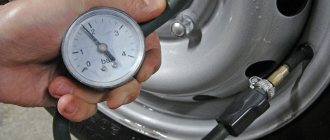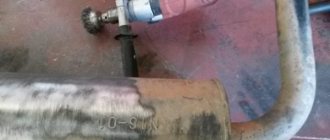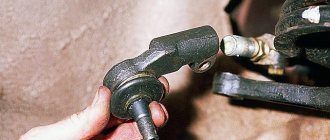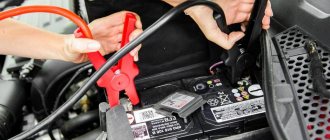Having received a driver's license and bought a car, it is worth driving for some time on not very busy roads and practicing parking in places where this action can be done as simply as possible. This must be done not only because you still have too little driving experience, but also because you need to get used to your new iron friend and feel the dimensions of the car. At this stage, many people wonder how to feel the dimensions of the car if I am a beginner. It is the sense of size that allows you to perform any maneuvers without violating your own and others’ safety.
Recommendations and tips: how to feel the dimensions of a car.
Dimensions
The concept of dimensions usually refers to the height, length and width of the car. But the machine is not only in a static position; it also has dynamic dimensions. Those who have carefully studied in a driving school know that there are six main indicators:
- A straight line that continues the wheels – left and right.
- Continuation line of the front bumper.
- Rear bumper.
- Front axle.
- Rear axle.
These parameters are completely different for different brands and not only beginners, but also quite experienced drivers need to get used to them. You can feel them well only after some time has passed - this is the experience of traveling in this particular car. Only after feeling his car, the driver can easily fit into a dense traffic flow or park in a very small and inconvenient space. The same feeling allows you to avoid bumps on the road or move on rough terrain. It’s quite easy to spot a novice driving; many of them try to crane their necks during the trip and try to look at the road in front of the bumper. Such drivers can often see various minor damage to the bumper, front and rear, or headlights. All this is most often the result of unsuccessful parking. You can try to avoid this, because even minor repairs often cost a very tidy sum.
Why learn to feel the dimensions of a car?
The feeling of your car is necessary for safe driving. A correct understanding of the size of a car will help you park deftly, change lanes, overtake vehicles in front, move in traffic and avoid obstacles.
There are two types of dimensions:
- static;
- dynamic.
Static – these are the main parameters of the car, its dimensions.
Dynamic - these are the actual distances from the edge of the body to a conditional obstacle, which is determined in the direction of movement. The driver, as he approaches the actual point, calculates the approximate distance to it. The distance is determined in dynamite - in motion.
It is spatial orientation that will help the driver not to hit curbs and other vehicles. If you brake in time before an obstacle, you can avoid a collision. And an erroneous assessment of the distance leads not only to scratches and other damage to the car’s paintwork, but also to more serious consequences: accidents and dents.
To feel the dimensions, you need to develop a special skill. You can purchase it during driving practice, or work it out specifically. The skill will be useful in various situations:
- in a parking lot - it will help you drive into a narrow space without hitting abandoned cars with your bumper or fender;
- on the road - when changing lanes, estimate the distance to neighboring cars, while maintaining distance in traffic jams, when passing vehicles on narrow sections of the roadway, when giving priority to crossings;
- when entering the garage, the feeling of the car’s own size will tell you when it is necessary to stop the car so that you can close the gate and calmly get out of the car.
To get a consultation
Developing a sense of size
For a good driver, the feeling of the car occurs automatically, as if subconsciously, and the goal of any beginner is to achieve exactly this level. To the question of how a beginner can get used to the size, the answer is clear - you need to not be lazy and do some self-preparation. Experienced motorists and driving instructors talk about several groups of possible complexes:
- Completing a complex of individual, or self-guided, training using improvised or stationary means.
- Individual preparatory work on the car.
- Completing training using assistive electronic devices.
We got into a new car and need to go straight away: what to do?
The question often arises of how to learn to feel the dimensions of a car if there is very little time and there is no time to train. In this case, it is important to remain calm and follow the plan. First, you need to ensure optimal visibility by adjusting the mirrors, seat height and distance from the steering wheel. It is strictly not recommended to recline the seat; the backrest is as vertical as possible. You will be able to relax after getting used to the dimensions.
The first maneuvers should be performed to a minimum. Back up only if absolutely necessary, avoid changing lanes until you feel confident. And the main thing is not to be afraid, but to sit down immediately and drive slowly, gradually assessing the distance. Experienced drivers will only need a few minutes to appreciate all the dimensions. Beginners will need more time. Experience definitely comes after the start of the trip.
Individual car preparation
The adequacy of driving will depend on how comfortable, and most importantly, how correctly the driver sits behind the wheel. Proper seating reduces unnecessary driver movements and speeds up the decision-making process. This is achieved due to the fact that the driver has the correct position of his arms and legs, and in addition, sufficient visibility, without unnecessary bending and peeking. To achieve the optimal fit, the driver needs to make a special adjustment. Adjusting the driver's seat and steering wheel
- Sit in the driver's seat and adjust it just for you. Ideally, you need to fully depress the clutch and move the seat forward or backward so that it is comfortable and there is no desire to stretch. The backrest is adjustable so that when using your legs you do not have to move your entire body.
- Do the same with the steering wheel - your palm should fit between the rim of the steering wheel and your knees, and at the same time the second hand should be extended above the steering wheel and touch its top point with your wrist.
How to understand the dimensions of a car: beginner mistakes
The problem of car feel is especially acute for drivers without experience. Beginners who have recently received a driver's license complain: they don't feel the size of the car. In the first year of their practice, motorists are faced with problems of parking and maneuvering in narrow areas: it is difficult for them to turn around in a small area, in limited conditions, among many other obstacles.
When I got behind the wheel for the first time, it seemed to me that I was sitting in the center, and to the right and left of me there was the same distance to the wheels. Until now, after 10 years of driving experience, probably, like many drivers, I feel better the left dimensions - along the driver's seat.
As you can see, first of all you should understand that there is a greater distance to the right wheel than to the left.
The second mistake beginners make is trying to see what is in front of the bumper, looking over the hood. For this reason, many novice drivers move the driver's seat closer to the windshield, resting against the steering wheel. Should not be doing that. The driver needs to look at the road, and not at the wheels. You will be able to feel the size of the car when you gain sufficient skill.
And one more piece of advice – the main thing is to learn how to use mirrors. In the mirror, it seems that neighboring cars are further away than in reality. You think that the car behind you is still far away, since it looks quite small in the mirror, but in reality it is just an optical illusion.
IT IS IMPORTANT TO KNOW. The side and rear view mirrors have a blind spot. A car's blind spot is the space around the car that is not reflected in the mirrors. The driver may not be able to see oncoming vehicles from his seat. Therefore, it is worth remembering that before starting a maneuver, you need to first look in the mirrors several times, making sure that it is safe.
Exercises to bring the feeling of a car to automaticity
There is a fairly wide variety of training options for inexperienced drivers, which allow you to quickly feel the dimensions of the car. We want to introduce you to the most effective ones.
Beacons
This is the simplest, but no less useful way to feel the dimensions. For this method we will need the following items that are absolutely safe for the car:
- Cones of any bright color.
- Plastic bottles filled with sand. For better visibility, you can stick bright flags into the bottles.
- Sacks or cardboard boxes filled with something very soft.
- Old tires.
The next step will be to install these beacons. Now you can start working directly.
- The driver must stop his car so that his front bumper, first the central part, and then the sides, touches the installed beacon. It’s important to touch, and not knock over or miss – this happens about the tenth or fifteenth time.
- Then you need to practice the same exercise with the rear bumper. These exercises should be brought to automaticity.
- After completing the first two stages, you need to move on. We mark with beacons the contours of two cars with a distance of 9 - 10 meters. Next, we begin to practice the parallel parking method, which is considered quite difficult.
- We put tall sticks in bottles with sand that will imitate gates and begin to work out the passage. First, the distance between the bottles should be approximately equal to the width of your car + 1 meter. Then we gradually narrow the distance, reducing it by 10 cm each time. The exercise will be considered completed if you can drive the car into a gap that exceeds the dimensions of the vehicle by only 10 cm.
Practicing the sense of wheel line
To learn to feel the line of the wheels you need to work hard. To do this, we again use improvised means, this could be a plastic bottle or a small cardboard box. We place the prepared object in front of the car and alternately run over it first with the left and then with the right wheel. After this exercise, place these objects at a distance of a meter from each other and drive in such a way that they are between the wheels.
After practicing these skills, use the same algorithm of actions only when driving in reverse. This is a rather difficult exercise, but if done systematically, you will learn to estimate the dimensions of the car in a short time.
Adjust the rear view mirrors
Before you start driving, look in the mirrors; if your view is difficult, you need to adjust them. The rear window of the car should be completely visible in the rearview mirror, and you should not sit up in your seat or retract your head. And the side mirrors should reflect the edge of your car’s body at the level of the handles and the adjacent lane.
Looking in your mirrors when changing lanes, it may seem that the car in the next lane is still far away, but be careful, distance can be deceiving. Perform the maneuver, making sure it is completely safe; over time, you will easily navigate the space and assess the road situation.
Change lane training
It will help you figure out how to feel the dimensions of a car by repeating the “parking in a confined space” exercise. Plastic tall objects come to the rescue. On an empty site, they imitate the lines of the curb and the dimensions of standing cars, between which you will have to squeeze. The best option, of course, is to actually drive into a courtyard or parking lot near a hypermarket. But for beginners it is better to practice in desert places first.
For example, let's take the Tiida Nissan model. The dimensions of the car are the same as those of most popular sedans. It is not recommended to choose smaller vehicles for training. The selected type of car fits into all classic garages, helping in the future to quickly assess the sufficient size of a parking space from inside the car.
Training should be carried out at different times of the day. At night, distances begin to be perceived differently due to the headlights. On a bright day, fewer accidents occur, according to statistics. Even professionals make mistakes due to fatigue or after a hectic evening. Similarly, it is worth training constantly so as not to waste money on expensive repairs in the future.
Tips for beginners
The more time you devote to training, the better. It is impossible to feel the dimensions without proper practice, so you should not limit your studies only to lessons in a driving school. Professional drivers recommend that novice motorists adhere to the following recommendations:
- do not try to see anything under the wheels of the car while driving;
- Don't focus solely on the road ahead;
- take into account that in the side mirrors objects appear smaller than they actually are;
- Pay more attention to moving backwards during training.
You can learn how to drive safely only with an instructor. Self-study will allow you to consolidate and improve the acquired skills, so they cannot be ignored, but it is also inadvisable to refuse professional help. If you want to become a confident driver and enjoy your trips, sign up for courses at the Vector driving school.
Important aspects
The main mistake of beginners is the desire to see what is happening in front of the bumper; this habit is very undesirable. In addition, it is dangerous when driving: when you drive, you need to look only in front of you, and not in front of the bumper.
When you reverse park, it is important to adjust the mirrors correctly; they will become your main assistants. This setting looks like this: the external mirrors should be directed and show the rear axle wheels to the driver. External ones are used to feel the lateral outlines. Pay attention to the outermost area of the exterior mirrors.
When driving along a highway outside the city, if you need to change lanes, look in the appropriate side mirror. Often, inexperienced drivers cut off other road users because they do not understand what they actually need to do with these mirrors. You can only change lanes when you can see in the mirror the entire car that is moving behind you.










